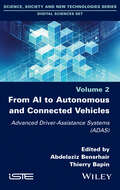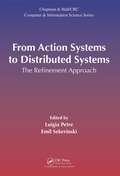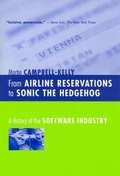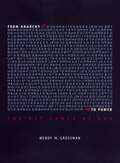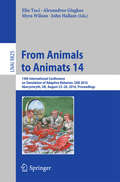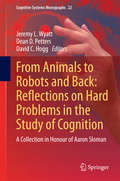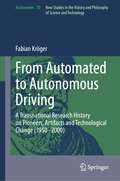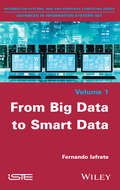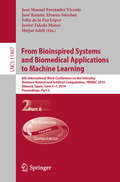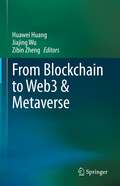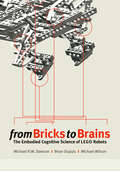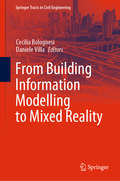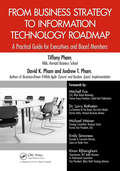- Table View
- List View
Frog and Toad are Doing Their Best [A Parody]: Bedtime Stories for Trying Times
by Jennie EgerdieAt home, work, and out in our ever-changing world, we're all just doing our best. In this modern parody, Frog and Toad are here to commiserate and lend some laughter.Full of wry humor and deep compassion for our modern vulnerabilities, the stories in Frog and Toad Are Doing Their Best perfectly capture the heartwarming authenticity of Lobel&’s famous amphibian friends while revealing razor-sharp truths about the world we live in today. Through Frog and Toad, we see the anxieties that are woven throughout our everyday existence, from our well-meaning but often-failed attempts at practicing self-care to our struggle to balance the gifts and burdens of technology. Toad ponders a variety of questionable schemes to pay off his credit cards, while Frog spends too much time scrolling through the newsfeed on his phone. But despite their daily frustrations and existential concerns, they know that having a friend to share life&’s burdens makes even the darkest days brighter.
From 2D to 3D Photonic Integrated Circuits (Synthesis Lectures on Emerging Engineering Technologies)
by Yasha YiThe integration of photonics and electronics has transformed the landscape of modern technology. At the forefront of this revolution is the development of Photonic Integrated Circuits (PICs). Historically rooted in the traditional 2-D fabrication processes inherited from electronic Integrated Circuits, PICs shifted to 3-D configurations, introducing new design philosophies that impact scalability, efficiency, and performance. This convergence of electronic and photonic circuits presents unique challenges and great opportunities. This book provides an introduction to photonic integrated circuits and the transition from 2D to 3D PICs. It then describes design and fabrication techniques of 3D PICs and related challenges and solutions. Finally, applications of 3D photonics, emerging technologies and industry outlook are also discussed.
From 5G to 6G: Technologies, Architecture, AI, and Security
by Abdulrahman YaraliFrom 5G to 6G Understand the transition to the sixth generation of wireless with this bold introduction The transition from the fifth generation of wireless communication (5G) to the coming sixth generation (6G) promises to be one of the most significant phases in the history of telecommunications. The technological, social, and logistical challenges promise to be significant, and meeting these challenges will determine the future of wireless communication. Experts and professionals across dozens of fields and industries are beginning to reckon seriously with these challenges as the 6G revolution approaches. From 5G to 6G provides an overview of this transition, offering a snapshot of a moment in which 5G is establishing itself and 6G draws ever nearer. It focuses on recent advances in wireless technology that brings 6G closer to reality, as well as the near-term challenges that still have to be met for this transition to succeed. The result is an essential book for anyone wishing to understand the future of wireless telecommunications in an increasingly connected world. From 5G to 6G readers will also find: 6G applications to both AI and Machine Learning, technologies which loom ever larger in wireless communication Discussion of subjects including smart healthcare, cybersecurity, extended reality, and more Treatment of the ongoing infrastructural and technological requirements for 6G From 5G to 6G is essential for researchers and academics in wireless communication and computer science, as well as for undergraduates in related subjects and professionals in wireless-adjacent fields.
From AI to Autonomous and Connected Vehicles: Advanced Driver-Assistance Systems (ADAS)
by Abdelaziz Bensrhair Thierry BapinThe main topic of this book is the recent development of on-board advanced driver-assistance systems (ADAS), which we can already tell will eventually contribute to the autonomous and connected vehicles of tomorrow.With the development of automated mobility, it becomes necessary to design a series of modules which, from the data produced by on-board or remote information sources, will enable the construction of a completely automated driving system. These modules are perception, decision and action. State-of-the-art AI techniques and their potential applications in the field of autonomous vehicles are described.Perception systems, focusing on visual sensors, the decision module and the prototyping, testing and evaluation of ADAS systems are all presented for effective implementation on autonomous and connected vehicles.This book also addresses cooperative systems, such as pedestrian detection, as well as the legal issues in the use of autonomous vehicles in open environments.
From Action Systems to Distributed Systems: The Refinement Approach
by Emil Sekerinski Luigia PetreFormal methods traditionally address the question of transforming software engineering into a mature engineering discipline. This essentially refers to trusting that the software-intensive systems that form our society's infrastructures are behaving according to their specifications. More recently, formal methods are also used to understand propert
From Adult Education to the Learning Society: 21 Years of the International Journal of Lifelong Education (Education Heritage)
by Peter JarvisThis unique text provides a valuable route map to the development of thinking in adult education and lifelong learning. It includes more than twenty-five seminal articles from the first two decades of the International Journal of Lifelong Education, written by leading authors in the field from the UK, the USA, Australia and Europe. Compiled to show the development of the field, the articles are divided into four sections: From Ault Education… …to Lifelong Education …and Lifelong Learning …to the Learning Society and Beyond. The specially written Introduction by the editor contextualises the selection and introduces readers to the main issues and current thinking in the field. This is the only text of its kind to demonstrate practice and policy internationally over this period, and as the collection of articles are now available in one easy-access place, this is an excellent resource for students and scholars.
From Airline Reservations to Sonic the Hedgehog: A History of the Software Industry
by Martin Campbell-KellyFrom its first glimmerings in the 1950s, the software industry has evolved to become the fourth largest industrial sector of the US economy. Starting with a handful of software contractors who produced specialized programs for the few existing machines, the industry grew to include producers of corporate software packages and then makers of mass-market products and recreational software. This book tells the story of each of these types of firm, focusing on the products they developed, the business models they followed, and the markets they served. By describing the breadth of this industry, Martin Campbell-Kelly corrects the popular misconception that one firm is at the center of the software universe. He also tells the story of lucrative software products such as IBM's CICS and SAP's R/3, which, though little known to the general public, lie at the heart of today's information infrastructure. With its wealth of industry data and its thoughtful judgments, this book will become a starting point for all future investigations of this fundamental component of computer history.
From Anarchy to Power: The Net Comes of Age
by Wendy GrossmanYesterday's battles over internet turf were fought on the net itself: today's battles are fought in government committees, in Congress, on the stock exchange, and in the marketplace. What was once an experimental ground for electronic commerce is now the hottest part of our economic infrastructure. In From Anarchy to Power, Wendy Grossman explores the new dispensation on the net and tackles the questions that trouble every online user: How vulnerable are the internet and world wide web to malicious cyber hackers? What are the limits of privacy online? How real is internet addiction and to what extent is the news media responsible for this phenomenon? Are women and minorities at a disadvantage in cyberspace? How is the increasing power of big business changing internet culture? We learn about the political economy of the internet including issues of copyright law, corporate control and cryptography legislation. Throughout the book the emphasis is on the international dimensions of the net, focusing on privacy and censorship in the United States, Europe and Canada and the hitherto ignored contributions of other countries in the development of the net. Entertaining and informative From Anarchy to Power is required reading for anyone who wants to know where the new digital economy is heading.
From Animals to Animats 14
by Elio Tuci Alexandros Giagkos Myra Wilson John HallamThis book constitutes the proceedings of the 14th International Conference on Simulation of Adaptive Behavior, SAB 2016, held in Aberystwyth, UK, in August 2016. The 31 papers presented in this volume were carefully reviewed and selected from 45 submissions. They cover the main areas in animat research, including the animat approach and methodology, perception and motor control, learning and adaptation, evolution, and collective and social behavior.
From Animals to Animats 15: 15th International Conference on Simulation of Adaptive Behavior, SAB 2018, Frankfurt/Main, Germany, August 14-17, 2018, Proceedings (Lecture Notes in Computer Science #10994)
by John Hallam Poramate Manoonpong Jørgen Christian Larsen Xiaofeng Xiong Jochen TrieschThis book constitutes the refereed proceedings of the 15th International Conference on Simulation of Adaptive Behavior, SAB 2018, held in Frankfurt/Main, Germany, in August 2018.The 21 papers presented were carefully reviewed and selected from 39 submissions. They cover the main areas in animat research, including the animat approach and methodology, perception and motor control, action selection and navigation, learning and adaptation, and collective and social behavior.
From Animals to Animats 16: 16th International Conference on Simulation of Adaptive Behavior, SAB 2022, Cergy-Pontoise, France, September 20–23, 2022, Proceedings (Lecture Notes in Computer Science #13499)
by Myra Wilson Lola Cañamero Philippe Gaussier Sofiane Boucenna Nicolas CuperlierThis book constitutes the refereed proceedings of the 16th International Conference on Simulation of Adaptive Behavior, SAB 2022, held in Cergy-Pontoise, France, in September 2022.The 17 papers presented in this volume were carefully reviewed and selected from 23 submissions. They were organized in topical sections as follows: Embodiment; Brain-Inspired Control, Adaptation, and Learning; Bio-inspired Vision and navigation; Affective and Social Cognition and Collective Intelligence.
From Animals to Animats 17: 17th International Conference on Simulation of Adaptive Behavior, SAB 2024, Irvine, CA, USA, September 9–12, 2024, Proceedings (Lecture Notes in Computer Science #14993)
by Jeffrey Krichmar Oliver BrockThis book constitutes the refereed proceedings of the 17th International Conference on Simulation of Adaptive Behavior, SAB 2024, held in Irvine, CA, USA, during September 9–12, 2024. The 26 full papers included in this book were carefully reviewed and selected from 30 submissions. They were organized in topical sections as follows: Bio-Inspired Navigation; Biomimetic Robots; Collective Behavior; Evolutionary Approaches to Adaptive Behavior; Motor Learning and Problem Solving and Decision-Making.
From Animals to Robots and Back: Reflections on Hard Problems in the Study of Cognition
by Jeremy L. Wyatt Dean D. Petters David C. HoggCognitive Science is a discipline that brings together research in natural and artificial systems and this is clearly reflected in the diverse contributions to From Animals to Robots and Back. In tribute to Aaron Sloman and his pioneering work in Cognitive Science and Artificial Intelligence, the editors have collected a unique collection of cross-disciplinary papers that include work on: · intelligent robotics; · philosophy of cognitive science; · emotional research · computational vision; · comparative psychology; and · human-computer interaction. Key themes such as the importance of taking an architectural view in approaching cognition, run through the text. Drawing on the expertize of leading international researchers, contemporary debates in the study of natural and artificial cognition are addressed from complementary and contrasting perspectives with key issues being outlined at various levels of abstraction. From Animals to Robots and Back, will give readers with backgrounds in the study of both natural and artificial cognition an important window on the state of the art in cognitive systems research.
From Astrophysics to Unconventional Computation: Essays Presented to Susan Stepney on the Occasion of her 60th Birthday (Emergence, Complexity and Computation #35)
by Andrew Adamatzky Vivien KendonThis Festschrift is a tribute to Susan Stepney’s ideas and achievements in the areas of computer science, formal specifications and proofs, complex systems, unconventional computing, artificial chemistry, and artificial life. All chapters were written by internationally recognised leaders in computer science, physics, mathematics, and engineering. The book shares fascinating ideas, algorithms and implementations related to the formal specification of programming languages and applications, behavioural inheritance, modelling and analysis of complex systems, parallel computing and non-universality, growing cities, artificial life, evolving artificial neural networks, and unconventional computing. Accordingly, it offers an insightful and enjoyable work for readers from all walks of life, from undergraduate students to university professors, from mathematicians, computers scientists and engineers to physicists, chemists and biologists.
From Atom Optics to Quantum Simulation
by Sebastian WillThis thesis explores ultracold quantum gases of bosonic and fermionic atoms in optical lattices. The highly controllable experimental setting discussed in this work, has opened the door to new insights into static and dynamical properties of ultracold quantum matter. One of the highlights reported here is the development and application of a novel time-resolved spectroscopy technique for quantum many-body systems. By following the dynamical evolution of a many-body system after a quantum quench, the author shows how the important energy scales of the underlying Hamiltonian can be measured with high precision. This achievement, its application, and many other exciting results make this thesis of interest to a broad audience ranging from quantum optics to condensed matter physics. A lucid style of writing accompanied by a series of excellent figures make the work accessible to readers outside the rapidly growing research field of ultracold atoms.
From Automated to Autonomous Driving: A Transnational Research History on Pioneers, Artifacts and Technological Change (1950-2000) (Archimedes #70)
by Fabian KrögerThis book presents the most important milestones of the research on automated and autonomous driving in the United States, Japan and Europe throughout five decades (1950-2000). Drawing on sources from the automotive industry, electrical engineering, the robotics and AI-domain and military institutions, it retraces the transition from the guidance-cable approach to vehicle-based sensor and vision systems. Giving a detailed overview of the technical concepts, artefacts, research vehicles and robots, the book presents the transnational engineering efforts that started long before Silicon Valley entered the field. In addition, the book also uniquely details the role of the military in the domain of vehicle automation. This all ensures the book is of great interest to historians of technology, practitioners in engineering disciplines, scholars working in mobility studies, journalists, and political decision makers.
From Big Data to Smart Data
by Fernando IafrateA pragmatic approach to Big Data by taking the reader on a journey between Big Data (what it is) and the Smart Data (what it is for). Today's decision making can be reached via information (related to the data), knowledge (related to people and processes), and timing (the capacity to decide, act and react at the right time). The huge increase in volume of data traffic, and its format (unstructured data such as blogs, logs, and video) generated by the "digitalization" of our world modifies radically our relationship to the space (in motion) and time, dimension and by capillarity, the enterprise vision of performance monitoring and optimization.
From Big Data to Smart Data
by Fernando IafrateA pragmatic approach to Big Data by taking the reader on a journey between Big Data (what it is) and the Smart Data (what it is for). Today’s decision making can be reached via information (related to the data), knowledge (related to people and processes), and timing (the capacity to decide, act and react at the right time). The huge increase in volume of data traffic, and its format (unstructured data such as blogs, logs, and video) generated by the “digitalization” of our world modifies radically our relationship to the space (in motion) and time, dimension and by capillarity, the enterprise vision of performance monitoring and optimization.
From Bioinspired Systems and Biomedical Applications to Machine Learning: 8th International Work-Conference on the Interplay Between Natural and Artificial Computation, IWINAC 2019, Almería, Spain, June 3–7, 2019, Proceedings, Part II (Lecture Notes in Computer Science #11487)
by Hojjat Adeli José Manuel Ferrández Vicente José Ramón Álvarez-Sánchez Félix de la Paz López Javier Toledo MoreoThe two volume set LNCS 11486 and 11487 constitutes the proceedings of the International Work-Conference on the Interplay Between Natural and Artificial Computation, IWINAC 2019, held in Almería, Spain,, in June 2019. The total of 103 contributions was carefully reviewed and selected from 190 submissions during two rounds of reviewing and improvement. The papers are organized in two volumes, one on understanding the brain function and emotions, addressing topics such as new tools for analyzing neural data, or detection emotional states, or interfacing with physical systems. The second volume deals with bioinspired systems and biomedical applications to machine learning and contains papers related bioinspired programming strategies and all the contributions oriented to the computational solutions to engineering problems in different applications domains, as biomedical systems, or big data solutions.
From Blockchain to Web3 & Metaverse
by Zibin Zheng Jiajing Wu Huawei HuangThe Metaverse seamlessly integrates the real world with the virtual world and allows avatars to engage in a broad range of activities including entertainment, social networking, and trading. In this book, we dive into the Metaverse by discussing how blockchains connect various Metaverse components, digital currencies, and blockchain-empowered applications in the virtual world. On the other hand, Web3 has also attracted considerable attention due to its uniquely decentralized characteristics. The digital economy, currently undergoing a rapid development, is a critical driver to highly efficient societies. It is imperative that we investigate how to use Web3 technologies to address the critical concerns encountered during the development of the digital economy by fully exploring Web3. In this book, we also share insights into the Web3-based ecosystem in the Metaverse; topics of interest include decentralized finance, digital assets, the asset-trading market, etc. Unlike most works on the subject, this book mainly concentrates on insights and discussions regarding blockchain, the Metaverse and Web3. In other words, it focuses on using blockchain technologies to enable an ecosystem for both the Metaverse and Web3. Topics addressed include blockchain fundamentals, smart contracts, value circulation in the Metaverse, the connection between the Metaverse and Web3, the establishment of the Metaverse on the basis of blockchain technologies, decentralized autonomous organization, decentralized storage, digital economy, Web3-based economic systems for the Metaverse, etc. This book will be a valuable resource for students, researchers, engineers, and policymakers working in various areas related to blockchain, the Metaverse and Web3. We hope that it will also inspire readers from academia and industry alike, and ultimately help them create a truly open, fair, and rational ecosystem for the Metaverse and Web3.
From Born-Physical to Born-Virtual: 24th International Conference on Asian Digital Libraries, ICADL 2022, Hanoi, Vietnam, November 30 – December 2, 2022, Proceedings (Lecture Notes in Computer Science #13636)
by Yuen-Hsien Tseng Hoa N. Nguyen Marie KatsuraiThis book constitutes the refereed proceedings of the 24th International Conference on Asia-Pacific Digital Libraries, ICADL 2022, which was held in November/December 2022. The 14 full, 18 short, and 12 poster papers presented in this volume were carefully reviewed and selected from 78 submissions. Based on significant contributions, the full and short papers have been classified into the following topics: intelligent document analysis; neural-based knowledge extraction; knowledge discovery for enhancing collaboration; smart search and annotation; cultural data collection and analysis; scholarly data processing; data archive and management; research activities and digital library; and trends in digital library.
From Brains to Systems
by Leslie S. Smith Igor Aleksander Amir Hussain Antonio Chella Ricardo Sanz Carlos Hernández Jaime Gómez RamirezBrain Inspired Cognitive Systems - BICS 2010 aims to bring together leading scientists and engineers who use analytic and synthetic methods both to understand the astonishing processing properties of biological systems and specifically of the brain, and to exploit such knowledge to advance engineering methods to build artificial systems with higher levels of cognitive competence. BICS is a meeting point of brain scientists and cognitive systems engineers where cross-domain ideas are fostered in the hope of getting emerging insights on the nature, operation and extractable capabilities of brains. This multiple approach is necessary because the progressively more accurate data about the brain is producing a growing need of a quantitative understanding and an associated capacity to manipulate this data and translate it into engineering applications rooted in sound theories. BICS 2010 is intended for both researchers that aim to build brain inspired systems with higher cognitive competences, and for life scientists who use and develop mathematical and engineering approaches for a better understanding of complex biological systems like the brain. Four major interlaced focal symposia are planned for this conference and these are organized into patterns that encourage cross-fertilization across the symposia topics. This emphasizes the role of BICS as a major meeting point for researchers and practitioners in the areas of biological and artificial cognitive systems. Debates across disciplines will enrich researchers with complementary perspectives from diverse scientific fields. BICS 2010 will take place July 14-16, 2010, in Madrid, Spain.
From Bricks to Brains
by Michael Wilson Michael R.W. Dawson Brian DupuisFrom Bricks to Brains introduces embodied cognitive science, and illustrates its foundational ideas through the construction and observation of LEGO Mindstorms robots. Discussing the characteristics that distinguish embodied cognitive science from classical cognitive science, From Bricks to Brains places a renewed emphasis on sensing and acting, the importance of embodiment, the exploration of distributed notions of control, and the development of theories by synthesizing simple systems and exploring their behaviour. Numerous examples are used to illustrate a key theme: the importance of an agent's environment. Even simple agents, such as LEGO robots, are capable of exhibiting complex behaviour when they can sense and affect the world around them.
From Building Information Modelling to Mixed Reality (Springer Tracts in Civil Engineering)
by Daniele Villa Cecilia BolognesiThis book reports on the latest advances in using BIM modelling to achieve the semantic enrichment of objects, allowing them to be used both as multidimensional databases – as comprehensive sources of information for finalizing various types of documentation in the building industry – and as modelling tools for the construction of virtual environments. Having advanced to a new stage of development, BIM modelling is now being applied in a range of increasingly complex contexts, and for various new purposes. This book examines the role that virtual reality and related technologies such as AI and IoT can play in preserving and disseminating our cultural heritage and built environment.
From Business Strategy to Information Technology Roadmap: A Practical Guide for Executives and Board Members
by Tiffany Pham David K. Pham Andrew PhamWhether you are a CEO, CFO, board member, or an IT executive, From Business Strategy to Information Technology Roadmap: A Practical Guide for Executives and Board Members lays out a practical, how-to approach to identifying business strategies and creating value-driven technology roadmaps in your organization. Unlike many other books on the subject, you will not find theories or grandiose ideas here. This book uses numerous examples, illustrations, and case studies to show you how to solve the real-world problems that business executives and technology leaders face on a day-to-day basis.Filled with actionable advice you can use immediately, the authors introduce Agile and the Lean mindset in a manner that the people in your business and technology departments can easily understand. Ideal for executives in both the commercial and nonprofit sectors, it includes two case studies: one about a commercial family business that thrived to become a multi-million-dollar company and the other about a nonprofit association based in New York City that fights against child illiteracy.



